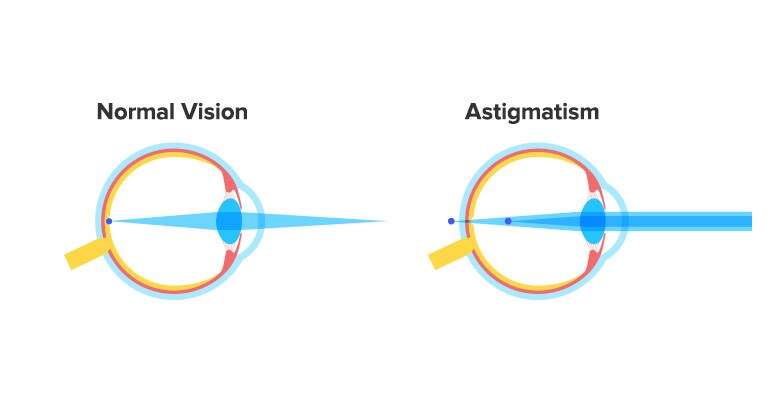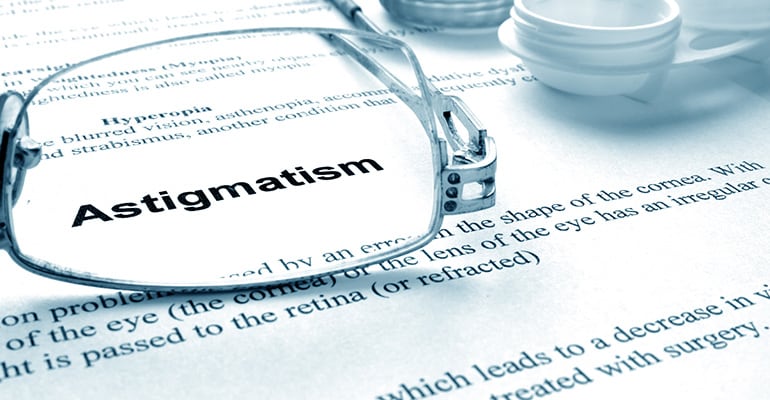Stigmatism vs. Astigmatism: Differences, Symptoms, Diagnosis, and Treatment
Jul 04, 2024

Astigmatism is a lot more common than most people think, 33% of people in the US have astigmatism, and it's nearly as common as being short or far-sighted.
If you've heard of astigmatism then you've probably come across the name stigmatism too and wondered what the difference is between these eye conditions.
We'll discuss everything you need to know about astigmatism below, including what causes this eye condition, the different types of astigmatism, and how it can be corrected.
Stigmatism Vs Astigmatism - What's the Difference?
Stigmatism doesn't exist, it's just a mistype of Astigmatism, so if you are reading about astigmatism vs stigmatism then they likely mean astigmatism! So you're probably now wondering what astigmatism is.
Eye astigmatism is a refractive defect that happens when the cornea or shape of the eye has an irregular shape.
This means when the light enters the eye it focuses on more than one point on the retina at various angles, this then causes distorted or blurred vision. Often the results of this mean headaches and trouble with vision at night due to light flares.
What Causes Astigmatism?
Now you've learned what's an eye astigmatism, what causes it? Well, there is no single cause of Astigmatism, but most of the time, the eye condition comes from genetics. Injuries and trauma can also potentially cause astigmatism if they affect the shape of the cornea.
Other causes could be Keratoconus, a medical condition that causes the cornea to bulge, or eye surgery.
The Different Types Of Astigmatism
Eye Astigmatism can come in different types, we’ve listed them below.
-
Myopic Astigmatism - Principal meridians are nearsighted meaning a combination of myopia and astigmatism.
-
Hyperopic Astigmatism - Principal meridians are farsighted meaning a blend of hyperopia and astigmatism.
-
Mixed Astigmatism: - Principal meridians are a mix of farsighted and nearsighted and astigmatism is the primary refractive issue.
Other ways astigmatism can be described are Corneal astigmatism which has defects in the cornea and Lenticular astigmatism which means a defect in the eye lens.
You may also see it described as regular astigmatism meaning the principal meridians are perpendicular 90 degrees apart or irregular astigmatism meaning the principal meridians are caused by injuries or eye surgery.
Principal meridians mean the greatest circumference of your eyeball.

Astigmatism Vs Normal Vision - What Are The Symptoms?
To determine if you have astigmatism it’s useful to know what vision with astigmatism vs normal vision is like.
These are the common symptoms of astigmatism.
-
Blurred vision at different distances.
-
Headaches due to straining eyes.
-
Bad night vision.
-
Seeing halos around lights.
-
Squinting.
-
Difficulty focusing on little details.
Often Astigmatism will be diagnosed through various tests such as a visual acuity test, keratometry test, refraction test, and slit lamp exam.

Can Astigmatism Be Corrected?
There are a few different ways Astigmatism can be corrected, most commonly through wearing eyeglasses, contact lenses, or eye surgery.
Can Glasses Fix Astigmatism?
If you are wondering, do glasses help astigmatism? Your corrected glasses can help with astigmatism when you have the correct prescriptions. Most of the time glasses can only help regular astigmatism by restoring the vision to 20/20.
If your astigmatism is a higher degree or you have irregular astigmatism then glasses might not be able to help.
Can Contact Lenses Fix Astigmatism?
Contact lenses can also be used for fixing astigmatism, the main contact lenses for this eye condition come in three types.
-
Toric lenses - These are a type of soft contact lenses that can help to correct astigmatism by having varied refraction levels aligning with specific meridians to allow for detailed correction. The smooth design of the contacts means they can bend and adjust to different levels of light.
-
Gas permeable lenses - These lenses are much more rigid than Toric ones but sometimes can integrate both materials. They work to correct astigmatism by replacing the refraction effect of the cornea, providing sharper detail than softer lenses and often being better for severe astigmatism.
-
Hybrid lenses - Astigmatism correction can be achieved with hybrid lenses too, these contact lenses have a rigid center and softer edges providing the best of both types. They require a fair amount of time to make due to the level of customizability.
Laser Eye Surgery For Astigmatism
Lastly, correcting astigmatism can be done through laser eye surgery. The two popular types are called LASIK and PRK. LASIK works by reshaping the cornea by using high-precision lasers to make it more symmetrical.
Implanting a Toric Intraocular Lens can also correct astigmatism but this is often more expensive.
What Level Of Astigmatism Requires Glasses?
There is no particular level of astigmatism that needs glasses, the need for correction with eyeglasses is often determined by your prescription decided by your optician.
Most of the time glasses are recommended if your astigmatism has a strength of 1.0 or more, but if it’s noticeably affecting your vision with a weaker strength, glasses can still help!
How Astigmatism Lights Look
A big part of astigmatism is how it makes lights appear to the eye during the dark.
Astigmatism lights vs normal vision makes lights seem fuzzy, streaky, or with a halo, most people who have astigmatism might not even know they have it if lights have always glared this way in their vision.
Astigmatism with lights is caused by the distorted cornea which stops adequate light from entering your eyes, making your pupils dilate and causing glares and streaks from the lights.

The Best Astigmatism Glasses
You should always take into account your unique prescription for your eye astigmatism when choosing glasses, but apart from this, we recommend taking into account these factors.
-
Lens material & frame - Normal plastic lenses are more affordable and can be used for low levels of astigmatism but more severe types often require thinner lenses for high prescriptions.
-
Lens coatings - People with astigmatism may want to opt for lens coatings such as anti-glare. These are the best glasses for astigmatism since they help increase the amount of light entering your eye.
At GlassesShop we have a huge variety of prescription glasses for astigmatism, especially reading glasses for astigmatism, whether you want sunglasses for astigmatism or regular eyeglasses. We also have lens coatings for night driving or anti-glare to help with light glares.
Night Driving Glasses For Astigmatism
Most of the time, people suffer the most at night when driving due to the fuzzy headlights and glaring traffic lights.
Night driving glasses for astigmatism will often have an anti-reflective coating, you can buy yellow tinted glasses for night driving which help block blue light but these are often non-prescription.
We have a range of anti-reflective coated glasses at GlassesShop for people who want glasses for night driving with astigmatism.
Shop Your Prescription Glasses With The GlassesShop
We have 1000s of eyeglasses on offer at GlassesShop, catering to people with astigmatism. If you need prescription glasses, sunglasses, or anti-reflective lenses, we have it all.
All of our glasses have a 365-day guarantee and we also offer a virtual try-on service if you want to see how your astigmatism frames look before buying. Just enter your prescription and we will customize your glasses for you.
